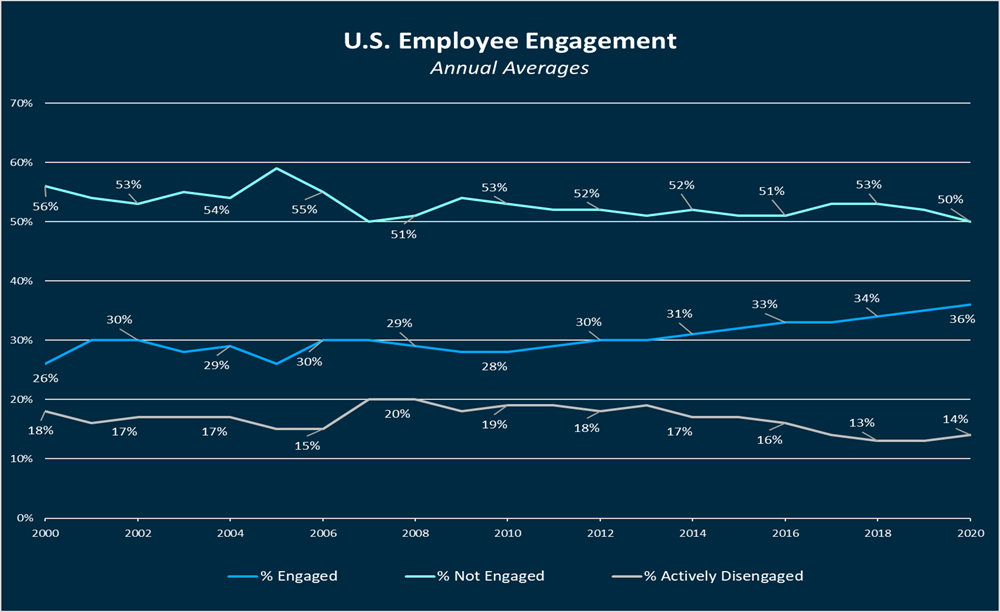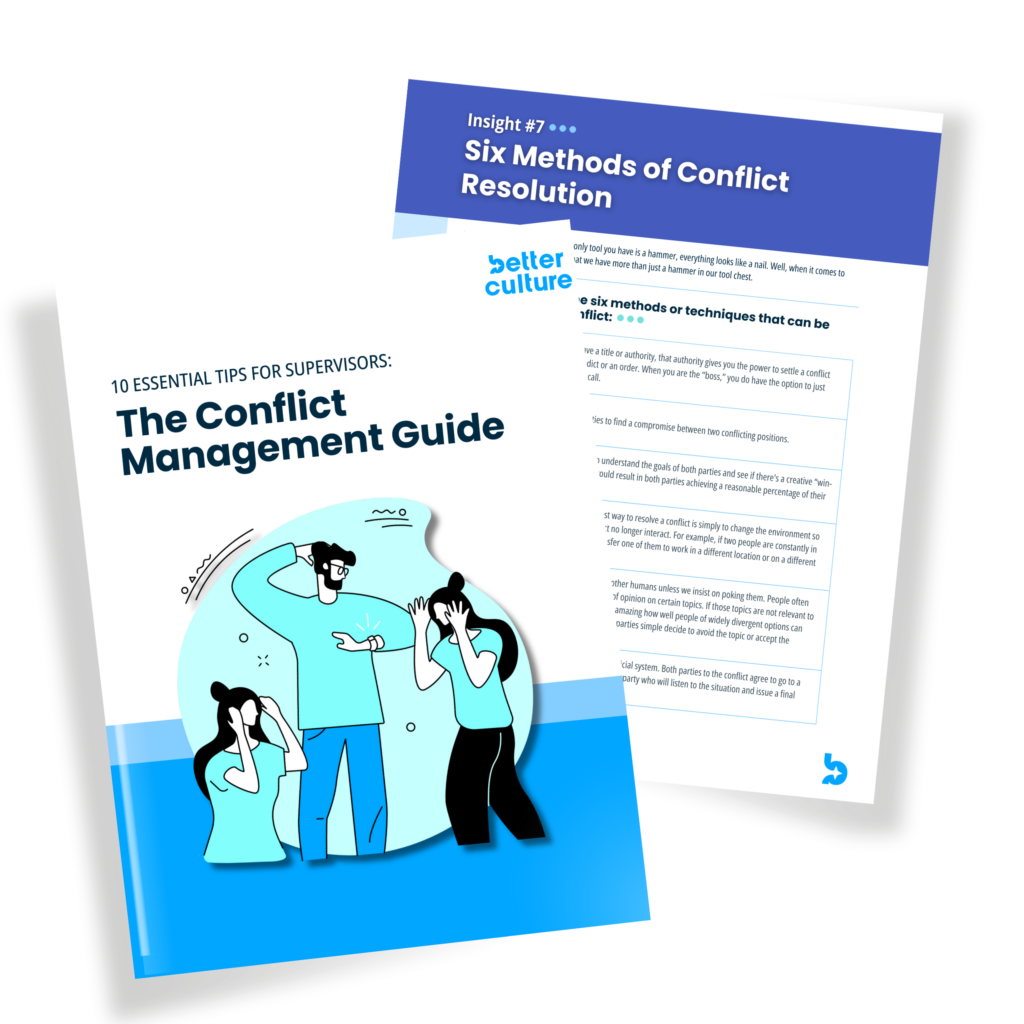Today, more than ever, organizations understand the value and power of “culture.” But how should organizations measure their culture? How can they know where they have room for improvement? And if they focus on those areas, how can they know if they’re making progress?
For most organizations, the best answer to these questions is to run an employee engagement survey at some regular interval (often annual). BetterCulture has been running employee engagement surveys for clients for over a decade, and we’ve seen and learned a lot along the way.
This article will help you maximize the impact of running an employee engagement survey. We share best practices that will help you take your culture to the next level, as well as common survey missteps that will inhibit your ability to build and protect a great culture.
Company culture and employee engagement have been priorities for organizations worldwide since the early 2000s. Using data published by Gallup, here is a summary of employee engagement in the U.S. from 2000-2020.

In the graph above featuring data from Gallup, you can see that the percentage of employees in the US who are engaged at work has been trending upward ever so slowly. However, we can tell you from a decade of personal experience, individual employers can move the culture needle much, much faster (if they want to)!
There are clear reasons why many companies have not been successful in improving employee engagement (in fact, we’ve built a resource called Big Mistakes Leaders Make that lays out the most common issues we see).
In this article, we will drill down into one of those big mistakes, which we call “measurement missteps.”
A Great Employee Engagement Survey (and Process)
- Inspire employee participation and trust. Without good participation and honest feedback, the survey results are useless.
- Accurately assess cultural health and employee sentiment. This may sound obvious, but many organizations use surveys that ask confusing questions or fail to ask the questions that are most central to employee engagement and overall cultural health.
- Provide results across a wide range of factors that impact culture. The goal with most engagement surveys is to benchmark current cultural health, understand employee morale, and identify specific opportunities for improvement. We recommend a robust survey that offers insight into multiple areas of cultural health. Here are the 14 Core Factors we use in our BetterCulture Engagement Survey.
- Show survey results for subgroups. While overall company results are helpful, the most actionable data often emerges from a more granular breakdown of company results into a variety of subgroups such as location, department, and/or team. It’s also helpful to look for differences across demographic groupings including age, gender, tenure, race, compensation (salary vs. hourly), and employment (full-time vs. part-time). Gaining insight into your company’s various micro cultures greatly enhances your ability to take strategic action.
- Allow you to share an overview of high-level results. Employees who take the time to provide their input through a survey will appreciate the opportunity to see an overview of the results. Don’t make the mistake of being completely transparent and sharing all survey results with all employees. The vast majority of employees simply want to know their voice was heard, the input was appreciated, and a plan is in place to benefit from employee feedback.
- Provide actionable results. The engagement survey should identify a few growth opportunities that can be impacted and improved through focused effort. It should also identify a few strengths (and it’s important to take at least a moment to celebrate the positives, as it will create helpful momentum as you begin to work on the growth opportunities).
- Lead you to take action. If you don’t have the time or resolve to use the survey results, your company would be wise to not survey in the first place.
General Employee Engagement Survey Mistakes to Avoid
Now that we’ve discussed what an employee engagement survey process should look like, let’s talk about what it should not look like. BetterCulture has worked with tons of companies that have used varying employee engagement survey tools and processes prior to subscribing with BetterCulture. Here are four engagement survey mistakes we have seen companies make over and over again:
#1: Asking the wrong questions.
If a doctor starts with the wrong questions, their diagnosis and treatment won’t be optimal (and may even be harmful). The same goes for engagement surveys. If you don’t ask clear, meaningful questions, the results you get back will be muddled, and maybe even counterproductive.
Several years ago, we started working with a client that had designed and administered their own survey using SurveyMonkey. That sounded all well and good, until they realized they asked some “double barreled” questions. A double barreled question is a great way to ruin the validity of your survey and irritate survey takers, because the question asks about two or more issues but leaves room for just a single response. Here are two examples:
- I get along with my manager and coworkers
- I am pleased with my salary and benefits
These two questions should have been asked as four questions. Doing so allows employees to accurately respond in all scenarios.
- I get along with my manager
- I get along with my coworkers
- I am pleased with my salary
- I am pleased with my benefits
Needless to say, this particular client made a smart move seeking professional support the next time around. In addition to helping this client avoid asking double barreled questions, we helped them ask survey questions that were more helpful from a diagnostic perspective.
Here are 14 major themes we believe your engagement survey questions should assess.
#2: A bad user experience.
The survey should take no longer than 15 minutes to complete. Every question should be clear, easy to understand, and simple to answer. If questions are confusing or it takes too long to complete, the survey results won’t be statistically reliable or valid. Garbage in, garbage out.
Ratings scales should be intuitive and easy to interpret. Some surveys use the exact same ratings scale throughout the entire survey (a 5-point, 7-point, or 9-point Likert scale is most common). Using a consistent scale and simple, clear questions will make for a positive user experience (and promote more valid results).
Note: more advanced surveys may also have a few “lie scale” questions to flag or screen out any employees who may not be taking the time to carefully read and respond to each question. This is not an essential element for an engagement survey, but using this level of sophistication will increase the validity of survey results.
#3: Self-administering an employee engagement survey.
If you want genuine, truthful feedback, you must ensure your employees that their responses will be anonymous and confidential.
This requires two things. First, creating a perception of anonymity. Second, actually making that perception of anonymity a reality by treating the information you collect confidentially. On first blush, that may sound simple and obvious. But we have seen well-intended organizations make major blunders on each of these fronts.
The Director of HR for a manufacturing client we worked with built and ran their own survey. This company’s management team had a high level of integrity. They built a survey and administered it themselves. Management had absolutely no interest in (or ability to) identify who said what on the survey. But when an underperforming employee was terminated (appropriately so) shortly after the survey, a rumor started that the termination was because of what the employee said on their survey.
This rumor was inaccurate, but a significant portion of the employee base became skeptical of management and jaded toward any future attempts to survey for employee sentiment. Their decision to build and run their own survey did damage to their culture.
Another word of caution. Be prepared for some managers to want to know, “Who said that?” If your survey breaks down data by department or offers a comments section to collect narrative responses, some managers may become upset by feedback and want to try to figure out which employee said what. If you are not careful with the design of your survey and the presentation of results, this common phenomenon can cause harmful conflict and erode employee trust.
We believe it’s a mistake to try to build and administer your own survey, because it is impossible to assure the perception of anonymity to your employees without hiring an outside survey vendor. A reputable vendor will ensure that employee privacy is protected and also advise on what you should (and should not) do with the results you are provided.
#4: No follow-up.
This is the #1 mistake we see. Companies run an engagement survey with noble intentions. Then they get busy (or confused/overwhelmed) and fail to follow through with any meaningful strategy to share and take action based on the data. (Keep reading for our advice on what you should do after running an employee engagement survey.)
Survey Vendor Selection Mistakes
When you decide to run an engagement survey, it’s important to select the right survey partner. Here are some questions to help you with that decision.
- Why are you running an engagement survey? If it’s simply because almost every other company is doing it, you need more clarity. There are two general reasons to run a survey:
- You want general employee engagement data. Overall cultural trend data will help you monitor overall employee engagement and whether your company is progressing, maintaining, or regressing in terms of overall cultural health. A simple survey is best for this purpose, with as few as 5 questions.
- You want detailed diagnostic information to help you identify and capitalize on specific areas where your company has opportunities for growth. Providing this type of detailed information to a talented chief culture officer will allow them to help every supervisor and team execute a personalized growth plan.
- What are the right survey questions? This may seem obvious, but companies waste a lot of time and money using survey questions that don’t align with their goals for running the survey in the first place. For example, if you want general data to measure progress over time, go with a really concise survey like the Gallup Q12. However, if you’re looking for more diagnostic value that will enhance your company’s ability to implement a Strategic Vision for Cultural Health, go with a more robust option like our BetterCulture Employee Engagement Survey.
- Are they responsive? Will the survey vendor work around your schedule, or do they expect you to work around theirs? How prompt will they be in generating your survey report? If they estimate it to be longer than three weeks after the close of your survey, find a better partner.
- Is there a multi-year contract? Many survey vendors will try to lock your company into a multi-year contract. It’s a sign that their product or service may not be as good as their sales people say it is.
- Will they provide a 100% satisfaction guarantee? Consider asking for it, because with engagement surveys, many providers will overpromise and underperform.
Congrats, You’ve Received Your Survey Results…Now Don’t Make These Mistakes
Costly mistakes are often made by companies after they receive their survey results. We’ve heard countless executives admit their company made at least some of these missteps:
- They didn’t share the survey results. This happens more often than you may think. Sometimes companies genuinely don’t know what to do with the results, so they do nothing. Other times leaders fail to recognize that employees would appreciate hearing and seeing a summary of the results. In other words, these leaders do review and make use the results, but they foolishly keep it a secret.
- They used the survey results punitively. Want to do damage to your culture and ensure you will never be able to get valid survey results again? There two surefire ways to accomplish that: 1) use the results to discipline, demote, or terminate employees; or 2) allow leaders to retaliate against employees whose responses didn’t align with what they wanted to hear. Yep, that will do it.
- They overpromised or failed to execute a follow-up plan. Don’t set the bar too high. You don’t get bonus points for setting a stretch goal here. Over-promising and under-delivering on how rapidly or significantly you can implement organizational change will burn you. We encourage you to create some cushion on both your timeline and goals. For example, if you have a goal of giving more opportunities for employee input, and you believe you can schedule an executive roundtable meeting with every employee within 3 months, commit to scheduling meetings with every employee who is interested within 6 months.
A Simple Process for Sharing and Using Survey Results
We recommend a simple, 3-step process after an engagement survey. You want to communicate:
- Strengths. Find 2-3 company strengths that showed up in the survey report. These should be areas that employees can celebrate and feel good about.
- Growth Opportunities. Find 2-3 opportunities for growth that were discovered through the survey process. These should be tangible actions or changes that employees can see and will appreciate.
- A Plan. Lay out a plan that you will execute over several months to a year.
If you follow this process, you’ll show employees that you are genuinely interested in their input, took the time to listen, and are serious about taking action. Don’t make it any more complicated than that.



